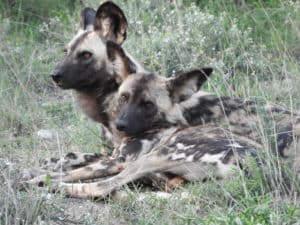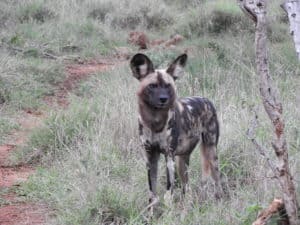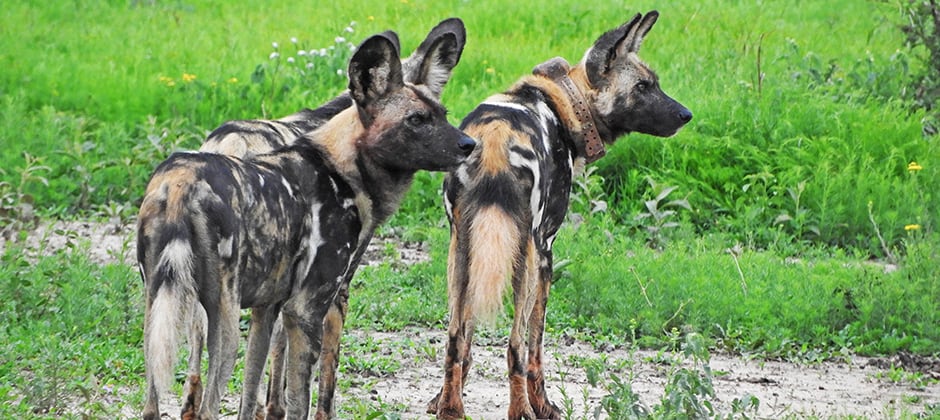Share this article
TWS2021: Zoos provide healthy painted dogs gene pool
African painted dogs are among the most endangered canids in the world. These predators range widely, albeit thinly, in various pockets of the continent in the wild. The largest contiguous ecosystem they roam in stretches across Botswana and neighboring countries. Other much smaller populations are found as far afield as Libya, Algeria, Senegal, and Ethiopia.
Given their need for extremely large ranges for hunting, the main threat facing painted dogs is human activity, particularly from habitat destruction and conflicts with farmers. As a result, the International Union for Conservation of Nature considers African painted dogs (Lycaon pictus), also known as African wild dogs, endangered.
Zoos around the world keep captive populations of painted dogs, and given the precarious state of the animals in the wild, some of these zoos may one day need to provide dogs for reintroduction projects. Because of this, it’s increasingly important to get an accurate sense of the gene flow of painted dogs at the various zoos keeping the dogs in Europe, southern Africa, Australia and North America, said TWS member Cassandra Miller-Butterworth, an associate professor of biology at Pennsylvania State University Beaver.

Captive populations of painted dogs may serve as reservoirs to bolster small groups in the wild in future reintroductions. Credit: Cassandra Miller-Butterworth
The ancestry of captive painted dogs is recorded in so-called studbooks, similar to the type used by horse breeders. These books record the ancestry of each individual so that captive breeders can best focus on healthy genetic diversity when pairing individuals. But some of this information may not be completely accurate—especially in cases where several individuals were imported from the wild and the parentage wasn’t known. Miller-Butterworth and her colleagues wanted to bolster the information in the studbook with genetic analyses.
Focusing on zoos in the United States and Canada in recent research presented at The Wildlife Society’s virtual 2021 Annual Conference, they analyzed 109 tissue samples from animals at 34 zoos and institutions collected for several years up to 2018—about 80% of the captive population in North America. These included 61 males and 48 females.
Miller-Butterworth led a study published in Genes that revealed the captive dogs in North America had fairly healthy genetic diversity, though not quite as diverse as in captive populations in Europe.
“The good news was we found that the population was not yet very inbred,” she said. “Overall, it has maintained pretty good genetic diversity—more so than wild populations that have been sampled.”
The analysis sorted out some of the uncertainty in parentage of some dogs as well and fixed a couple of errors in the studbook. In all, Miller-Butterworth and her colleagues assigned paternity to 10 unknown cases and fixed three errors where the parent was incorrectly recorded.
The researchers also estimated the effective population size—the number of dogs contributing to the next generation by breeding. Since painted dogs live in highly hierarchical packs, many of the dogs don’t breed, making it difficult sometimes for biologists who would want to introduce the genes of one particular animal, for example.
“The social hierarchy is so much in flux, even if [zoo staff] temporarily remove a dog to do a medical procedure to it, another dog can take its position in the hierarchy,” Miller-Butterworth said.
But the data her team collected can at least help biologists take actions to help maintain or improve diversity such as sterilizing overly inbred individuals or alpha males overrepresented in the gene pool.

Captive painted dogs in North America had fairly high genetic diversity. Credit: Cassandra Miller-Butterworth
The ultimate goal of these analyses, she said, is to coordinate genetic information about captive painted dogs with zoos in other continents in an effort to maintain high diversity. That way, the captive population could be managed globally rather than region by region, or even zoo by zoo.
Better information about these populations can also help wildlife managers make decisions about which animals not to mix, despite high diversity. Since some populations of painted dogs have been isolated for a long time, it’s possible that they have developed specific genetic adaptations to their environment. In some cases, for example, wildlife managers may not want to mix painted dogs with East African ancestry together with those that have ancestry from the south. In other cases, the genetic diversity of small population may be so limited that, in the interest of long-term preservation, there is no choice but to introduce genes from painted dogs whose ancestors came from farther away.
These questions are difficult to answer, Miller-Butterworth said, and will have to be made on a case-by-case basis. But she hopes her research can at least provide baseline data that managers can use to make those difficult decisions.
Header Image: African painted dogs are among the most endangered canids in the world. Credit: Cassandra Miller-Butterworth








